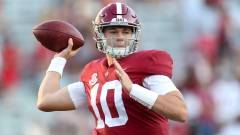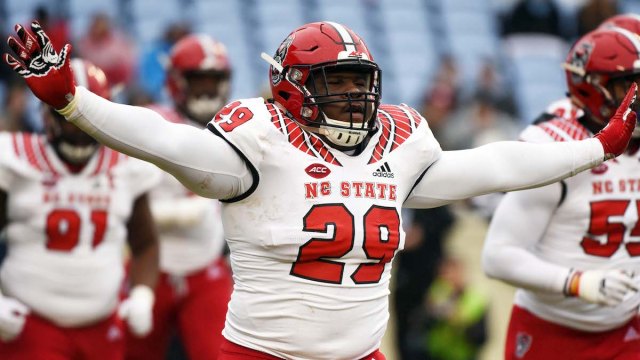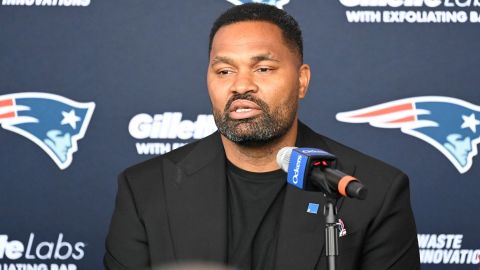In the weeks leading up to the 2021 NFL Draft, NESN.com will be taking a closer look at this year’s quarterback class and how each player could fit with the New England Patriots. Next up: Stanford’s Davis Mills.
Davis Mills, Stanford
6-foot-3 6/8, 217 pounds, 9 1/2-inch hands
Projected round: 2-3
2020 stats: 62.2 percent, 1,508 yards, seven touchdowns, three interceptions, 7.7 yards per attempt; 30 carries, 37 yards, three touchdowns (five games)
Strengths: Arm strength, accuracy, touch, anticipation, size
Weaknesses: Lack of starting experience, mobility, injury history, college production, decision-making, inconsistency
Testing numbers: 4.81-second 40-yard dash; 1.74-second 10-yard split; 32-inch vertical; 110-inch broad; 4.4-second short shuttle; 6.95-second three-cone drill (Stanford pro day)
Analysis: Quarterback is the Patriots’ biggest remaining need. This year’s draft class is loaded with QB talent, with five expected to come off the board in the top half of the first round.
But what if New England can’t land Alabama’s Mac Jones, Ohio State’s Justin Fields or North Dakota State’s Trey Lance? The Patriots aren’t scheduled to pick until No. 15, and Jones, Fields and Lance all could go top-10, along with the presumed 1-2 of Trevor Lawrence and Zach Wilson.
If an aggressive trade-up isn’t possible — or Bill Belichick opts to focus his first-round attention on a different position — the Patriots could shift their gaze to the next tier of signal-callers. Three are likely to hear their names called on Day 2 of the draft: Florida’s Kyle Trask, Texas A&M’s Kellen Mond and Mills.
What makes Mills an early-round prospect? For starters, he came to Stanford in 2017 as a highly touted recruit. The No. 1 quarterback recruit in the nation, in fact, ahead of future Alabama phenom and fifth overall pick Tua Tagovailoa.
Mills never lived up to those lofty expectations in college, but his film shows a number of desirable NFL traits: good size, strong arm and above-average anticipation and touch. He’s capable of zipping an on-target ball to a wideout as he makes his break or lofting a pass over a linebacker but in front of a lurking safety.
He delivered some impressive deep and intermediate completions into tight windows and displayed good accuracy overall, finishing the Cardinal’s COVID-shortened 2020 season with a completion percentage of 66.2 percent and an adjusted completion rate of 78.8 percent, per Pro Football Focus. The latter ranked ninth among all FBS quarterbacks. Stanford’s offense also featured more under-center work than many college systems, which should help Mills in his transition to the pros.
But despite his solid accuracy marks, Mills’ tape is littered with ill-advised and/or poorly placed throws, several of which resulted in ugly interceptions. He tossed just eight picks on 436 pass attempts over the past two seasons, but PFF’s charting credited him with 17 turnover-worthy plays. Too often, he misfired on passes into highly trafficked areas.
“He is one of the best middle-of-the-field passers in the draft,” The Athletic’s Dane Brugler wrote in his 2021 draft guide, “but needs time to grow and eliminate the ‘what are you doing?’ plays from his tape.”
That’s the most important factor to mention with Mills: he’s inexperienced. Lingering effects from multiple high school knee injuries sidelined him early in his Stanford tenure, and he didn’t become a full-time starter until midway through his third season with the program, when he replaced an injured K.J. Costello. Mills was the unquestioned QB1 in Palo Alto in 2020, but with the pandemic cleaving the Pac-12 schedule in half, he wound up starting just five games.
All told, Mills made just 11 total starts and appeared in 14 games in his college career. He attempted a total of 442 collegiate passes. Among the projected top eight QB prospects, only Lance, who played in a run-focused offense and had nearly his entire 2020 season wiped out by COVID, threw fewer (319). Trask and Mond attempted 815 and 1,370, respectively.
The team that drafts Mills will hope his play stabilizes as he accumulates experience. If that team is the Patriots, it would buck a long-standing trend of Belichick targeting more seasoned quarterback prospects.
The last six QBs drafted by New England — from Zac Robinson in 2010 to Jarrett Stidham in 2019 — all had at least 25 games of collegiate starting experience. The one before them (Kevin O’Connell, 2008) had 21. Mills’s 11 college starts would be the fewest by a Patriots-drafted quarterback since Matt Cassel, who backed up Carson Palmer and Matt Leinart at USC before New England picked him in the seventh round in 2005.
Also of note: Cassel is the only Pac-12 QB the Patriots have drafted under Belichick. Three of their last five have been SEC products.
Coincidentally, PFF’s 2021 draft guide compared Mills to Cassel, who, like the Stanford prospect, was a pocket passer with limited mobility. Mills did break off a few decent runs over the last two seasons and turned in a solid 6.96-second three-cone time with a 4.81-second 40 at his pro day, but he won’t be much of a rushing or scrambling threat at the next level.
Lance Zierlein had another notable comp for Mills in the QB’s NFL.com draft profile: Stidham, who’s currently second on the Patriots’ depth chart behind Cam Newton. Stidham is an inch shorter than Mills, but the two posted nearly identical testing numbers, save for Mills’ much quicker three-cone.
Stidham, a fourth-round pick two years ago, was significantly less accurate than Mills during his final season at Auburn, but his yards-per-attempt and average-depth-of-target marks were comparable. And Mills, it should be noted, ranks near the bottom of this year’s draft class in both of those categories.
Adding projected late-rounders Jamie Newman, Ian Book, Sam Ehlinger, Feleipe Franks and Shane Buechele to the aforementioned eight, Mills ranks 12th out of 13 in YPA (7.7), ahead of only Mond, and 12th out of 13 in ADOT (7.93, per PFF), ahead of only Franks. That means he, on average, threw shorter passes than his fellow 2021 NFL hopefuls.
There’s been chatter about Mills potentially sneaking into the tail end of the first round, but he’s more likely to come off the board in the second or third. That would put him in range of New England, which currently owns picks No. 46 and 96 on Day 2.
The upside is there with Mills. But we wonder whether the Patriots — assuming they miss out on the Big Five QBs — would gravitate more toward Mond, who started 44 games in the SEC and can move. Trask also has an experience edge (22 starts) and SEC pedigree.
More QB prospect profiles: Trey Lance, Zach Wilson, Justin Fields, Mac Jones









